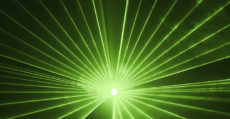
But what’s the big deal? Consumers can easily buy lasers that dwarf common presentation pointers in terms of intensity. While the beams of small pointers diverge over hundreds of feet, higher-intensity lasers travel hundreds of yards—easily posing a visual hazard.
These devices commonly exceed the standard 5 milliwatt (mW) limit imposed on pointers by the U.S. Food & Drug Administration (FDA). And still, the National Institute of Standards and Technology (NIST) found nearly 90 percent of green pointers—among a total of 122 laser pointers—were noncompliant, with one pointer more than 10 times over the limit.
Glaring dangers
Karl Citek, O.D., Ph.D., AOA Commission on Ophthalmic Standards chair, says it’s this particular set of laser devices that are heightening the risk for air crews and everyday consumers alike.
“You could easily hit an aircraft with these lasers,” Dr. Citek says. And of foremost concern for aircrews would be disability glare caused from the diffused beam. Flight controls would be obscured and vision outside the plane would diminish. But assume a pilot couldn’t avoid the beam, and a few seconds of exposure to the eye could cause retinal damage.
“Even brief exposure at those levels (over 50mW) can cause at least temporary retinal damage—especially in the green wavelengths—and possibly long-term damage if you cannot avoid the beam,” Dr. Citek says.
He noted a case report of a child who suffered a damaged fovea from a laser reflected off a mirror. It took months for normal vision to return.
Changing the discussion
Lasers are useful tools but can easily become dangerous in the wrong hands, which is why the FDA asks health care professionals to educate parents and children about safety. Only a year ago, the AOA weighed in on FDA proposed guidance for the laser industry.
Dr. Citek says because the “just don’t do it” education manner often meets defiant ears, he suggests taking a proactive approach: “If you do decide to play with a laser pointer, this is what can happen. Give them the facts.”
“These are not toys, and if parents give a laser pointer to a child, it should be with close supervision.”